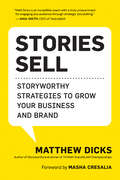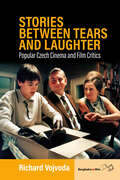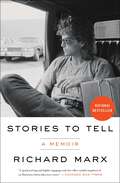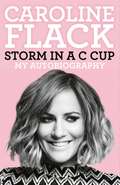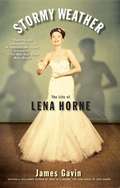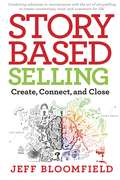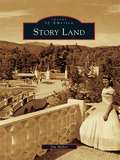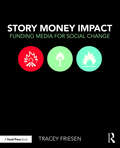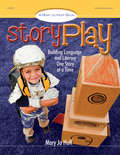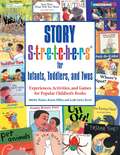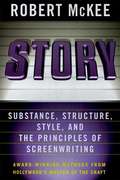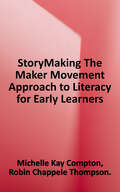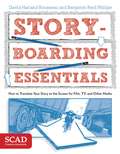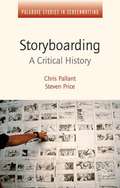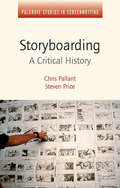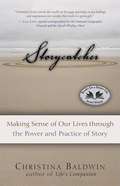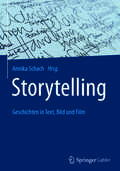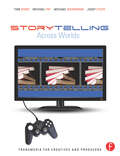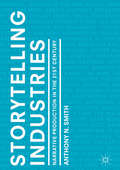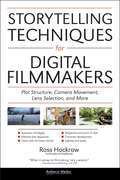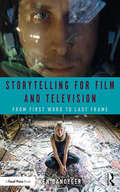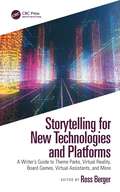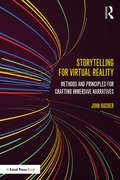- Table View
- List View
Stories Sell: Storyworthy Strategies to Grow Your Business and Brand
by Matthew DicksWIN CUSTOMERS AND BUILD BRANDS THROUGH THE POWER OF STORYTELLING Moth GrandSLAM all-time champion storyteller, writer, and business coach Matthew Dicks presents a guide to using the power of storytelling for success in business of any type or size. Matt has found that the basic principles of effective storytelling are universal, teachable, and more crucial than ever for business communication. Jam-packed with examples, Stories Sell reveals the ingredients of a compelling story and then demonstrates how they can be incorporated into persuasive marketing copy, productive face-to-face conversations, effective sales pitches, and presentations that people actually want to hear. Topics include: • The three elements of a winning story: stakes, suspense, and surprise • Finding the right narrative structure (and why beginning at the beginning isn’t always the best method) • The power of being vulnerable: how admitting your mistakes can build rapport with audiences • When and how to use humor • Zigging while others zag: making yourself stand out from competitors Whether you’re an online marketer, advertising professional, salesperson, small business owner, independent contractor, or Fortune 500 executive, Stories Sell will teach you to find your voice and get your message across for maximum impact and profit.
Stories between Tears and Laughter: Popular Czech Cinema and Film Critics
by Richard VojvodaWhile histories of Czech cinema often highlight the quality of Czechoslovak New Wave films made in the 1960s, post-socialist Czech cinema receives little attention. Through a methodology of historical reception, Stories between Tears and Laughter explores how attitudes towards post-socialist Czech cinema have shifted from viewing it as radical “art cinema” and more towards popular cinema. By analyzing publicity materials, reviews, and articles, Richard Vojvoda offers a new perspective on the notions of cultural value and quality that have been shaping the history of post-socialist Czech cinema.
Stories to Tell: A Memoir
by Richard Marx*National Bestseller* Legendary musician Richard Marx offers an enlightening, entertaining look at his life and career.Richard Marx is one of the most accomplished singer-songwriters in the history of popular music. His self-titled 1987 album went triple platinum and made him the first male solo artist (and second solo artist overall after Whitney Houston) to have four singles from their debut crack the top three on the Billboard Hot 100. His follow-up, 1989&’s Repeat Offender, was an even bigger smash, going quadruple platinum and landing two singles at number one. He has written fourteen number one songs in total, shared a Song of the Year Grammy with Luther Vandross, and collaborated with a variety of artists including NSYNC, Josh Groban, Natalie Cole, and Keith Urban. Lately, he&’s also become a Twitter celebrity thanks to his outspokenness on social issues and his ability to out-troll his trolls. In Stories to Tell, Marx uses this same engaging, straight-talking style to look back on his life and career. He writes of how Kenny Rogers changed a single line of a song he&’d written for him then asked for a 50% cut—which inspired Marx to write one of his biggest hits. He tells the uncanny story of how he wound up curled up on the couch of Olivia Newton-John, his childhood crush, watching Xanadu. He shares the tribulations of working with the all-female hair metal band Vixen and appearing in their video. Yet amid these entertaining celebrity encounters, Marx offers a more sobering assessment of the music business as he&’s experienced it over four decades—the challenges of navigating greedy executives and grueling tour schedules, and the rewards of connecting with thousands of fans at sold-out shows that make all the drama worthwhile. He also provides an illuminating look at his songwriting process and talks honestly about how his personal life has inspired his work, including finding love with wife Daisy Fuentes and the mystery illness that recently struck him—and that doctors haven&’t been able to solve. Stories to Tell is a remarkably candid, wildly entertaining memoir about the art and business of music.
Storm in a C Cup: My Autobiography
by Caroline FlackThe frank and insightful memoir from much-missed television star Caroline Flack. Known for her throaty laugh, edgy humour and quick-fire wit, showcased on some of Britain&’s most popular shows, Caroline Flack was the star of reality TV shows from The X Factor to Love Island, as well as a winner on Strictly. In Storm in a C Cup, Caroline reveals the laughter and pain behind the TV persona, from a sheltered Norfolk childhood shared with her twin sister, through her madcap student days, to the challenging career ladder, leading to eventual TV success – and its dark shadow, when intrusive media attention turned the dream into a nightmare. Caroline wears her heart on her sleeve, documenting her joys and heartbreaks with the humour, resilience and unflinching emotional honesty that made her one of television&’s most popular celebrities.
Storming the Barricades
by Larry ChristiansenChristiansen's goal is to instill the sense of adventure and spirit that is so important to successful warfare on the chessboard. He warns - the kind of ruthless, aggressive chess described and celebrated in this book is not for the faint-hearted! He discusses king hunting, ripping apart the king position and when not to attack.
Stormy Weather
by James GavinTHE "DEFINITIVE" (VANITY FAIR ) BIOGRAPHY OF LEGEND LENA HORNE--THE CELEBRATED STAR OF STAGE, MUSIC, AND FILM WHO BLAZED A TRAIL FOR AFRICAN AMERICANS IN HOLLYWOOD AND BEYONDDrawing on a wealth of unmined material and hundreds of interviews-- one of them with Lena Horne herself--critically acclaimed author James Gavin gives us a "deftly researched" (The Boston Globe) and authoritative portrait of the American icon. Horne broke down racial barriers in the entertainment industry in the 1940s and '50s even as she was limited mostly to guest singing appearances in splashy Hollywood musicals. Incorporating insights from the likes of Ruby Dee, Tony Bennett, Diahann Carroll, and Bobby Short, Stormy Weather reveals the many faces of this luminous, complex, strong-willed, passionate, even tragic woman--a stunning talent who inspired such giants as Barbra Streisand, Eartha Kitt, and Aretha Franklin.Cotton Club, Stormy Weather offers a fascinating portrait of a complex, even tragic Horne -- a stunning talent who inspired such giants of showbiz as Barbra Streisand, Eartha Kitt, and Aretha Franklin, but whose frustrations with racism, and with tumultuous, root-less childhood, left wounds too deep to heal. The woman who emerged was as angry as she was luminous. From the Cotton Club's glory days and the back lots of Hollywood's biggest studios to the glitzy but bigoted hotels of Las Vegas's heyday, this behind-the-scenes look at an American icon is as much a story of the limits of the American dream as it is a masterful, ground-breaking biography.
Story Based Selling
by Jeff BloomfieldAs a founder of a successful organization that trains and develops sales professionals, Jeff Bloomfield has given a lot of thought to why customers say yes. In Story-Based Selling: Create, Connect, and Close, Mr. Bloomfield says it's really no mystery. People buy from people they trust. They trust people they like, and they like people they connect to. And he believes that storytelling is the best way for salespeople-and all of us-to immediately connect to a customer's feelings of trust and liking. He thinks teaching sales professionals to close a deal by presenting their product, probing its mutual benefits, and overcoming the customer's objections and skepticism, is a waste of time. Instead, he urges them to tell a great story. Mr. Bloomfield calls upon the latest research in neuroscience to explain the process of communication. The truth is that during the salesperson's engagement with clients, people quickly base their decisions on how they feel, not the way they think, so trying to persuade someone by first imparting lifeless facts and figures is self-defeating. In fact, this information goes right to an area of the listener's brain (the left brain) that drives doubt and skepticism. To make a deal we need to connect with the parts of the customer's brain that inspire emotions of trust and empathy. By telling a story, we can immediately connect to these good gut feelings and drive away the client's fear of being sold. Mr. Bloomfield tells his own engaging stories while teaching step-by-step techniques of intentional storytelling-to create a fast connection with the listener, no matter who is buying or what a person wants to sell.
Story Land
by Jim MillerWhen sedans and station wagons replaced trains for vacationers heading to New Hampshire's rugged and picturesque White Mountains, new motels and attractions catering to middle-class families sprang up amidst the established grand hotels and diversions for socialites, artists, skiers, and hikers. In 1954, a tiny children's park inspired by a collection of storybook dolls opened in the quiet village of Glen. Through a unique combination of independent innovation and regional cooperation, Story Land has continually grown for more than 50 years through economic and cultural changes that undermined many amusement parks. Parents still travel great distances for a Story Land getaway with their children, just as their own parents did, sharing a common experience that is talked about between multiple generations at family gatherings. This photograph collection illustrates the unlikely beginnings and creative entrepreneurship behind one of New England's most memorable and enduring childhood institutions.
Story Money Impact: Funding media for social change
by Tracey FriesenStory Money Impact: Funding Media for Social Change by Tracey Friesen is a practical guide for media-makers, funders, and activists who share the common goal of creating an impact with their work. Today, social-issues storytellers are sharpening their craft, while funders with finite resources focus on reach, and strategic innovators bring more robust evaluation tools. Friesen illuminates the spark at the core of these three pursuits. Structured around stories from the front lines, Story Money Impact reveals best practices in the areas of documentary, digital content, and independent journalism. Here you will find: • Twenty-one stories from people behind such powerful works as CITIZENFOUR, The Corporation, Virunga, Being Caribou, Age of Stupid, and Food Inc. • Six key story ingredients for creating compelling content. • Six possible money sources for financing your work. • Six impact outcome goals to further your reach. • Seven practical worksheets for your own projects. • A companion website located at www.storymoneyimpact.com containing up-to-date information for those seeking the tools and inspiration to use media for social change.
Story Play: Building Language and Literacy One Story at a Time
by Mary Jo HuffWhen a story comes to "The End" it does not have to be the end of the story. Instead, teachers can continue the learning with activities and experiences to promote conversation about that story. Story Play encourages even the most inexperienced teacher, librarian, child care professional, or family member to become a storyteller with ideas for expanding stories into meaningful learning experiences. With stories, poems, songs, chants, and fingerplays, as well as ideas for working with puppets and props, Story Play brings all the fun of storytelling into the classroom in new ways. These easy-to-follow ideas focus on literacy skills and are perfect for engaged, active learning.
Story S-t-r-e-t-c-h-e-r-s for the Primary Grades, Revised: Activities to Expand Children's Books, Revised Edition
by Brian Scott Smith Shirley RainesThere is nothing that children love more than a good story. Story S-t-r-e-t-c-h-e-r-s for the Primary Grades, Revised connects 90 of the best children's books to early learning centers, stretching each story five ways with lively and entertaining activities that heighten reading readiness, sharpen comprehension skills, and expand the excitement of story time. Pulling the best stories from the original books, this new edition also features new children's books as well as old favorites, refreshed activities, and online references for expanding story experiences.
Story: Style, Structure, Substance, and the Principles of Screenwriting
by Robert MckeeRobert McKee's screenwriting workshops have earned him an international reputation for inspiring novices, refining works in progress and putting major screenwriting careers back on track. Quincy Jones, Diane Keaton, Gloria Steinem, Julia Roberts, John Cleese and David Bowie are just a few of his celebrity alumni. Writers, producers, development executives and agents all flock to his lecture series, praising it as a mesmerizing and intense learning experience. In Story, McKee expands on the concepts he teaches in his $450 seminars (considered a must by industry insiders), providing readers with the most comprehensive, integrated explanation of the craft of writing for the screen. No one better understands how all the elements of a screenplay fit together, and no one is better qualified to explain the "magic" of story construction and the relationship between structure and character than Robert McKee.
StoryMaking: The Maker Movement Approach to Literacy for Early Learners
by Robin Chappele Thompson Michelle Kay ComptonAfter studying the current research on literacy learning for young children, delving into the beliefs and schools of Reggio Emilia, and discovering the Maker Movement, the authors created StoryMaking. With great success, they implemented it in their diverse and large public school district. StoryMaking shares the processes, first steps, next steps, use for materials, and lessons learned so teachers can implement their versions in their classrooms. The book shares practical suggestions, student samples, photographs, anchor charts, and other forms of documentation.
Storyboarding Essentials: SCAD Creative Essentials (How to Translate Your Story to the Screen for Film, TV, and Other Media)
by Benjamin Reid Phillips David Harland RousseauA comprehensive guide to visual storytelling from Savannah College of Art and Design (SCAD), one of the world's leaders in sequential arts instruction. Storyboarding is the process of graphically organizing a project--a motion picture, animation, motion graphic, or interactive media sequence--in order to translate artists' ideas from story to screen. Whether you're a filmmaker, animator, ad director, writer, or video-game artist--storyboarding is a skill that is absolutely critical. Storyboarding Essentials covers everything students and working professionals need to master the art of writing and formatting scripts, creating frames, and following visual logic to create a cohesive narrative.
Storyboarding: A Critical History (Palgrave Studies In Screenwriting)
by Steven Price Chris PallantStoryboarding.
Storyboarding: A Critical History (Palgrave Studies in Screenwriting)
by Steven Price Chris PallantThis study provides the first book-length critical history of storyboarding, from the birth of cinema to the present day and beyond. It discusses the role of storyboarding in key films including Gone with the Wind , Psycho and The Empire Strikes Back , and is illustrated with a wide range of images.
Storycatcher: Making Sense of Our Lives Through the Power and Practice of Story
by Christina BaldwinStory is the heart of language. Story emotionally moves us to love and hate and can motivate us to change the whole course of our lives. Story can lift us beyond the borders of our individuality to imagine realities of other people, times, and places; to empathize with other beings; to extend our supposing far into the universe. Storytelling - both oral tradition and written word - is the foundation of being human. In her powerful new book, Christina Baldwin, one of the visionaries who started the personal writing movement, explores the vital necessity of re-creating a sacred common ground for each other's stories. Each chapter in Storycatcher is carried by a fascinating tale - about people, family, or community - intertwined with practical instruction about the nature of story, how it works and how we can practise it in our lives. The art of storycatching invites us to spend time speaking and listening, writing and reading, reclaiming the meaning missing from our lives. This book passionately calls for humanity to hang on to its voice, its love of reading and writing, and its understanding that story is our soul. Whether exploring the personal stories revealed in our private journals, the stories of family legacy, the underlying stories that drive our organizations, or the stories that define our broadest definitions of identity, Christina encourages us all to become storycatchers - people who value story and find ways in the midst of everyday life to practise storytelling. Baldwin shows us how new stories lay the framework for a new world.
Storytelling
by Annika SchachDas Buch pr#65533;sentiert eine textlinguistische Analyse von Texten zur Unternehmensgeschichte und widmet sich dem vielzitierten Storytelling-Trend. Anhand von Textexemplaren der DAX30-Unternehmen werden die Textfunktion, Themenentfaltung und Formulierungsspezifika untersucht. Ein besonderer Schwerpunkt liegt in der Fragestellung, inwieweit Narration als Vertextungsstrategie verwendet wird und wie sich die Textexemplare in einer Typologie beschreiben lassen. Die Arbeit stellt zudem einen Bezug zum medienwissenschaftlichen Framing-Ansatz her.
Storytelling Across Worlds: Transmedia for Creatives and Producers
by Tom DowdDon’t restrict your creative property to one media channel. Make the essential leap to transmedia! From film to television to games and beyond, Storytelling Across Worlds gives you the tools to weave a narrative universe across multiple platforms and meet the insatiable demand of today’s audience for its favorite creative property. This, the first primer in the field for both producers and writers, teaches you how to: * Employ film, television, games, novels, comics, and the web to build rich and immersive transmedia narratives * Create writing and production bibles for transmedia property * Monetize your stories across separate media channels * Manage transmedia brands, marketing, and rights * Work effectively with writers and producers in different areas of production * Engage audiences with transmedia storytelling Up-to-date examples of current transmedia and cross-media properties accompany each chapter and highlight this hot but sure-to-be enduring topic in modern media.
Storytelling Industries: Narrative Production in the 21st Century
by Anthony N. SmithThis book shows how the unique characteristics of traditionally differentiated media continue to determine narrative despite the recent digital convergence of media technologies. The author argues that media are now each largely defined by distinctive industrial practices that continue to preserve their identities and condition narrative production. Furthermore, the book demonstrates how a given medium’s variability in institutional and technological contexts influences diverse approaches to storytelling. By connecting US film, television, comic book and video game industries to their popular fictional characters and universes; including Star Wars, Batman, Game of Thrones and Grand Theft Auto; the book identifies how differences in industrial practice between media inform narrative production. This book is a must read for students and scholars interested in transmedia storytelling.
Storytelling Techniques for Digital Filmmakers
by Ross HockrowThe key elements of creating an effective film narrative--which involves a significant shift in mindset from still photography to motion capture--are detailed in this guide to becoming a standout digital videographer. Through teaching classic cinematic techniques for storytelling while addressing contemporary digital equipment and customer standards, the guide instructs such elements of filming as mixing the types of shots used, charting the plot, and introducing characters. Equipment use is also explored through the analysis of gear for camera movement and how to create ideal lighting. With a focus on high-definition filming, the book also provides invaluable information on obtaining high-quality audio and how to make the most of video editing.
Storytelling for Film and Television: From First Word to Last Frame
by Ken DancygerStorytelling for Film and Television is a theory and practice book which offers a definitive introduction to the art of storytelling through writing, directing, and editing. Author Ken Dancyger provides a comprehensive explanation of the tools that underpin successful narrative filmmaking and television production. The book takes a unique approach by connecting the different phases of the creative process of film and television production. It shows how writing, directing, and editing all contribute to the process of storytelling and function together to advance the narrative goals of a screenplay, to tell the best story. A case study approach provides numerous examples of effectiveness and brings together the core areas of aesthetics and production to make these concepts more accessible. Case studies include classic and modern films, foreign films, limited and series television, with examples including Breaking Bad, Game of Thrones, The Revenant, and Son of Saul. This is the ideal text for film and television production students at all levels. It is written in a style which makes it accessible to anybody interested in learning more about the storytelling process and is written for a global audience addressing a global industry.
Storytelling for New Technologies and Platforms: A Writer’s Guide to Theme Parks, Virtual Reality, Board Games, Virtual Assistants, and More
by Ross BergerWant to know what it’s like to write for a theme park attraction? Or an interactive toy? Or for a virtual reality game? Wait – those tell stories? And there are jobs for people to write them? Thanks to technology, interactive products and live experiences can now engage us with memorable characters and exciting adventures that were once only destined for the cinema. Storytelling for New Technologies and Platforms: A Writer’s Guide to Theme Parks, Virtual Reality, Board Games, Virtual Assistants, and More is a handbook for writers, students, producers, teachers, scholars, career changers, early tech adopters, and just about anyone who loves story and technology. As a collection of articles from some of the best creative writers in their medium, this book will prepare content creators of tomorrow to tackle some of today's most exhilarating creative challenges found on a screen ... or off! Key Features: Expert advice from several industry professionals who have worked for some of the world’s biggest tech and interactive companies. Best practices that not only guide writers on how to apply their craft to new fields, but also prepare them for the common ambiguity they will find in corporate and start-up environments. Breakdown of platforms that shows how tech capabilities can fulfill content expectations and how content can fulfill tech expectations. Basic storytelling mechanics customized to today’s popular technologies, live experiences, and traditional game platforms.
Storytelling for Virtual Reality: Methods and Principles for Crafting Immersive Narratives
by John BucherStorytelling for Virtual Reality serves as a bridge between students of new media and professionals working between the emerging world of VR technology and the art form of classical storytelling. Rather than examining purely the technical, the text focuses on the narrative and how stories can best be structured, created, and then told in virtual immersive spaces. Author John Bucher examines the timeless principles of storytelling and how they are being applied, transformed, and transcended in Virtual Reality. Interviews, conversations, and case studies with both pioneers and innovators in VR storytelling are featured, including industry leaders at LucasFilm, 20th Century Fox, Oculus, Insomniac Games, and Google. For more information about story, Virtual Reality, this book, and its author, please visit StorytellingforVR.com
